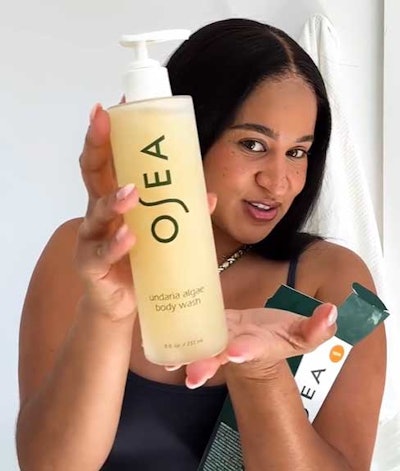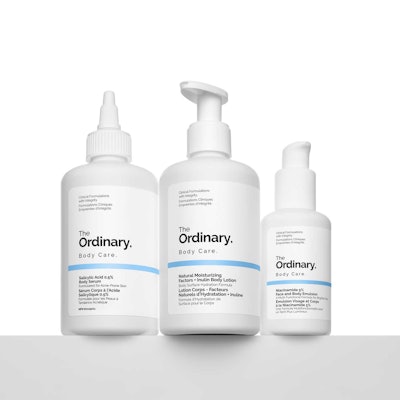
Body skin care is booming. Global Cosmetic Industry reported it’s been the fastest-growing sector in overall skin care in the first half of 2024, per Circana,1 driven by body spray sales that have grown in the triple digits. Add to this the double-digit growth for body creams, lotions and cleansers, as well as a 25% increase in consumer spending on prestige body products, and it makes you wonder: What’s driving this essential, "must-have" category? To uncover the answers, here we explore three new commercial launches from Bali Body, Osea and Philosophy, and survey four industry experts, including: Anushka Nadkarni, at Bentley Labs; Ron Robinson, of BeautyStat Cosmetics; Rita Silva, of The Ordinary/DECIEM; and Jean-Christophe Choulot, Ph.D., at Caudalíe.
Log in to view the full article
Body skin care is booming. Global Cosmetic Industry reported it’s been the fastest-growing sector in overall skin care in the first half of 2024, per Circana,1 driven by body spray sales that have grown in the triple digits. Add to this the double-digit growth for body creams, lotions and cleansers, as well as a 25% increase in consumer spending on prestige body products, and it makes you wonder: What’s driving this essential, "must-have" category? To uncover the answers, here we explore three new commercial launches from Bali Body, Osea and Philosophy, and survey four industry experts, including: Anushka Nadkarni, at Bentley Labs; Ron Robinson, of BeautyStat Cosmetics; Rita Silva, of The Ordinary/DECIEM; and Jean-Christophe Choulot, Ph.D., at Caudalíe.
See related archived article on body beauty.
Multifunctional Mash-up
The label claims and ingredients highlighted in recent launches provide clues – and most point to body care crossing into other categories for a mash-up of multifunctional effects.
Bali Body, for example, rolled out a Self Tanning Milk the company describes as “skin care meets tan.” Its bronzing effects are achieved through natural DHA, with additional “gradual and buildable” moisturizing effects featuring traditional facial care ingredients like hyaluronic acid, ceramides and vitamin C. These are said to deeply hydrate with anti-aging benefits, brighten skin and fade imperfections, and support the skin barrier while soothing sensitive, irritated skin.
 OSEA's new Undaria Algae Body Wash is receiving rave reviews on the brand's Instagram feed.OSEA Instagram reel
OSEA's new Undaria Algae Body Wash is receiving rave reviews on the brand's Instagram feed.OSEA Instagram reel
Osea’s Undaria Algae Body Wash leans into both nutritive and anti-aging claims, touting the marquee Undaria seaweed ingredient for its amino acid, antioxidant and nutrient content to mineralize skin. Interestingly, the product highlights being formulated with “5x more hydrating ingredients than before.” Does this mean body skin wasn’t getting enough hydration before? Or that body care is getting the facial skin care treatment? Notably, this product also contains the anti-aging active niacinamide.
Philosophy’s Scent-Sational Hydrating Bath and Shower Gel line emphasizes the fragrance factor, playfully dipping into food and beverage concepts with delectable scents including vanilla birthday cake, lemon custard, animal cracker, raspberry sorbet – even margarita and melon daiquiri. The company additionally underscores the gels provide “elevated” hydration, delivering an ultra-creamy lather and “skin-hugging” moisture for radiant skin.
Additional insights come from product developers themselves, several of whom, as noted, shared thoughts on the burgeoning body care market.
See related archived article on neck/body care and other topics.
Body Care = Skin Care Beyond Face
“‘Skin care beyond face’ has been one of the biggest trends in the [body care] market,” writes Anushka Nadkarni, product development and innovation lead at Bentley Labs. “This stems from the ever-growing body care market. The consumer now realizes that body is technically the same ‘skin,’ and needs to be protected, moisturized and generally taken care of, just as the face.” She also sees claims like anti-aging, barrier repair, moisturization, cleansing and glow making their way into the body care category.
“To that effect, some ingredients have also made their way into this category – mild acids, soothing actives, multi-weight HAs, niacinamide, ceramides and peptides. … Fragrance is [also] an unsung hero for body care,” Nadkarni continues. “I don't think fragrance is given the credit it deserves.”
See related archived article featuring expert opinions on body care.
Advanced and Targeted Body Skin Solutions – 6 Key Areas
“I’m seeing a trend of more body treatments being launched that are tackling advanced and specific body concerns,” says cosmetic chemist Ron Robinson, founder of the skin care brand BeautyStat. He highlighted six key areas of innovation:
- Extremely dry skin: “To target those with very dry skin, we are seeing more body hydrating serums powered with hyaluronic acid and other hydrating active ingredients. These specialized treatments are meant to be layered under more traditional emollient-based body moisturizers.”
- Acne: “The same active ingredients used to treat facial acne are being used to treat body acne: salicylic acid and benzoyl peroxide (BP). Salicylic acid works by exfoliating dead skin and oil build-up and BP works by killing the acne-causing bacteria.”
- Hyper-pigmentation: “To treat dark spots, uneven skin tone and scars, treatments that contain vitamin C, tranexamic acid, niacinamide and kojic acid work to exfoliate and help minimize the overproduction of melanin in order to even out skin tone and fade hyper-pigmentation.”
- Skin smoothing: “To treat rough [skin] texture, treatments that contain hydroxy acids and retinol work to exfoliate the skin and stimulate cell turnover to reveal softer, smoother skin.”
- Keratosis pilaris (KP): “KP is a skin condition that appears as rough goosebumps resembling the skin of a plucked chicken. This can be seen on the back of the arms. [Sometimes] mistaken for pimples, [these bumps] are actually plugs of dead skin cells that clog the hair follicle. Hydroxy acid-containing products can exfoliate and unclog the follicle in order to treat this concern."
- Firming and smoothing: “…[P]roducts with retinol can work to smooth the skin and improve sagging. Retinol works by helping to stimulate cell turnover and help boost collagen, which can help to firm and tighten the body skin.”
Divergent Body Product Paths: Active and Functional vs UX/Sensorial
“[Exploring new formats] is not something new, but for the past few years, body care has taken two very distinct paths – active-focused, functional body care or user experience-focused, fragranced body care,” Rita Silva, manager of scientific communications and brand engagement for The Ordinary/DECIEM, writes.
“Consumers are either looking for specific products that bring about noticeable skin care benefits and target their skin care concerns – be it blemishes, uneven tone, uneven texture, or even signs of aging; or for a sensorial experience that will enrich their day – be it for a few seconds while washing their hands or throughout the day by using products that impart a unique, luxurious fragrance or skin feel.”
Silva continues, “There's a lot more space to play in body care nowadays, and brands are taking this opportunity to explore new formats, claims and ingredients.”
In terms of enabling technologies, Silva sees consumers gravitating toward what’s familiar. “When it comes to functional body care, consumers are looking for the same ingredients that they have developed a trust-based relationship with for their facial skin care. Ingredients like exfoliating acids, niacinamide or retinoids have taken over, with consumers wanting to see long-term, lasting effects that only these actives can provide.
“As for [user experience] (UX)-focused body care, fragrance has taken over, with many brands scenting body care products with niche fragrances that were in the past reserved to [eau de parfums] (EDPs). Consumers that choose experience above function expect a luxury-like, unique experience with every layer of body care that they apply, and brands that achieve this will immediately stand out from the rest,” Silva adds.
6 Beauty-aligned Body Care Trends
“Like other beauty categories, body care is following the same trends,” shares Jean-Christophe Choulot, Ph.D., director of R&D for Caudalíe. He identified six key areas of innovation, including the following.
 Technologies to support main body care trends are what you might expect. For example, glycerin and hyaluronic acid, as featured in Caudalíe's Hyaluronic Nourishing Body Lotion, are essential for claims of hydration and skin barrier protection.Caudalíe
Technologies to support main body care trends are what you might expect. For example, glycerin and hyaluronic acid, as featured in Caudalíe's Hyaluronic Nourishing Body Lotion, are essential for claims of hydration and skin barrier protection.Caudalíe
- Sustainable and environmentally friendly products: “Consumers are increasingly looking for environmentally friendly products, with clean beauty claims, biodegradable packaging, waterless formulas and cruelty-free/vegan certifications.”
- Multifunctionality: “Many body care products are marketed as multi-purpose, such as moisturizers that also offer sun protection, anti-aging or exfoliating properties.”
- Skin barrier support: “There is a growing focus on products that protect and repair the skin barrier, leading to claims about restoring moisture, reducing transepidermal water loss (TEWL) and improving skin resilience.”
- Microbiome-friendly: “Interest in protecting the skin’s microbiome is growing, with claims to balance the skin’s natural bacteria and prevent disruptions to the skin flora.”
- Personalization: “Brands are offering personalized or customized body care solutions based on individual skin concerns, genetic testing or digital skin diagnostics.”
- Active body care: “Products that target areas of the body with active ingredients traditionally found in facial care (e.g., retinoids, niacinamide, ceramides) are trending. Body care is no longer just about hydration, but also about anti-aging, hyperpigmentation and cellulite reduction.”
Technologies to support these main body care trends are what you might expect. Per Choulot, hyaluronic acid and glycerin, for example, are essential for claims of hydration and skin barrier protection. Niacinamide is used to support the skin barrier, to brighten skin and to reduce inflammation. Peptides and retinoids, known for their anti-aging and skin-tightening properties, are commonly found in body creams targeting stretch marks, wrinkles and firmness.
Probiotics and prebiotics, including ingredients like Bifida ferment lysate, are used to support a healthy skin microbiome, while AHAs and BHAs such as glycolic and salicylic acid are used in body scrubs to target rough skin, ingrown hairs and hyperpigmentation.
Botanical extracts and oils including shea butter, aloe vera and marula oil are popular in clean beauty and sustainability claims, per Choulot, and offer moisturizing and soothing properties. Finally, encapsulation technologies support the delivery of actives such as retinol, ensuring its stability, slowing its release and reducing irritation while improving efficacy.
Choulot adds, “All of these actives will obviously need to be natural or biotech[-derived] in order to be renewable and vegan.”
Opportunity Knocks in Body Care
What areas in body care are untapped, presenting new opportunities? Robinson sets his sights on sun. “I think there’s an opportunity for more sheer, mineral sunscreen formula options for the body,” he writes.
Echoing Robinson’s earlier sentiments, Nadkarni points to specific body care concerns. “New trends and categories still requiring focus should cater to keratosis pilaris and intimate care. These also tie into inclusivity and body positivity.”
Choulot also sees an array of problem-specific opportunities in this space. “There is a need to develop products for body-specific skin concerns,” he explains. “[While] facial care is highly developed, body-specific concerns such as keratosis pilaris, cellulite, body acne and stretch marks still have gaps in personalized solutions.”
He also highlights the need for inclusive products for different skin tones. “Hyperpigmentation is more common in darker skin tones, but many body care lines do not offer targeted products for these concerns.”
In addition, innovative solutions beyond traditional deodorants could be developed for lasting odor protection. “A concept … [was] attempted a few years ago [to address] body odor with the development of a peptide blend blocking 2-nonenal – [which is] responsible for aging-related body odor,” he writes.
Men's body care is yet another area ripe for innovation. “While growing, men's-specific body care is still less developed than women's products, especially in terms of moisturizing and deodorizing that meet the needs of men's skin and preferences,” Choulot explains, adding that products to address concerns such as ingrown hairs, hair removal and hair growth are underrepresented.
Silva looks to innovation and education for answers. “I believe that there's space to explore additional actives beyond the familiar technologies that consumers already seek,” she writes.
“At The Ordinary, we have always believed in commoditizing ingredients to increase accessibility, and this is not limited to a handful of ingredients. There's always space for less-known ingredients to become familiar technologies, and consumer education (as well as effective formulation and testing) are a great way to achieve this.”
Scaling and Optimizing Body Care: The Challenges
While by now your juices for body care product ideas may be flowing, it is important to consider the challenges formulators face when developing body care products.
“As a cosmetic chemist, I find the hardest thing about formulating body products is doing so in a cost-effective way,” Robinson explained. “Most face treatments are 1 oz or 1.7 oz but body products need to be much larger in size in order to give the consumer enough product to use over their entire body. This can make these formulas more costly as you begin using more higher-cost active ingredients.”
Nadkarni seconded this opinion. “As fascinating as formulating for body care may sound, it comes with challenges. The biggest one is cost – the fill-weight for body products is 6-8 oz on average, so your formula cost goes significantly higher. However challenging, [though], body care is one of those trends that's here to stay.”
To Silva, the biggest challenge is “definitely the fine balance between ingredient concentration and safety thresholds.” She adds, “[and] since the product will be applied to a larger area of the body, some ingredients may be included at a lower concentration to account for this – a concentration that consumers might not associate with the highest and most effective concentration.
 (from L) The Ordinary brand's Salicylic Acid 0.5% Body Serum, Natural Moisturizing Factors Inulin Body Lotion and Niacinamide 5% Face and Body EmulsionThe Ordinary
(from L) The Ordinary brand's Salicylic Acid 0.5% Body Serum, Natural Moisturizing Factors Inulin Body Lotion and Niacinamide 5% Face and Body EmulsionThe Ordinary
“For example, when formulating our Salicylic Acid 0.5% Body Serum, we followed the SCCS recommendation for the maximum salicylic acid concentration in body products,” Silva continues. “While we know 2% is a common concentration for this ingredient, by following the latest recommendation by scientific committees that advise regulators, we know that we are both following the most up-to-date science while also future-proofing our formulation.”
Reiterating some earlier experts’ concerns, Choulot notes, “Body care products must maintain the effectiveness of active ingredients over larger surface areas than facial products, requiring careful formulation to ensure uniform distribution, absorption and effectiveness.”
Furthermore, texture and spreadability can pose issues. “Balancing rich moisture without creating a greasy or heavy feel on the skin, especially for products that need to spread over large surface areas, is a major challenge.” Choulot also sees ingredient cost as a limiting factor. “Using high concentrations of active ingredients in large volumes for the body can make formulations expensive, while maintaining an affordable price point is essential.”
Finally, besides cost, the ingredients themselves can pose physico-chemical formulating challenges. “Active ingredients are often unstable and degrade over time, especially in larger containers or warmer environments such as bathrooms,” Choulot explains. In addition, sensitivity to fragrance or other ingredients may be amplified across larger surface areas. “Like all cosmetics, body care products must have a pleasant scent, but applying a scented product to such a large body surface area must not be cloying.”
4 Key Considerations to Innovating in Body Care
Matching up all these insights and trends, in the end, Global Cosmetic Industry simmered it down to four key considerations to innovating in body care:
- Incorporating facial skin care ingredients and other actives like niacinamide and vitamin C;
- Leveraging claims such as anti-acne, anti-aging/longevity, etc.;
- Delivering sensory experiences, e.g., through a signature scent, sparkling effects or even warming/cooling sensations; and
- Focusing on value. Whether it’s via price point or proven efficacy, remember shoppers are in a choosy mood.1
References
1. Global Cosmetic Industry. (2024, Sep 4). 2024's fastest-growing skin care category goes beyond the face. Available at https://www.gcimagazine.com/brands-products/skin-care/article/22919650










